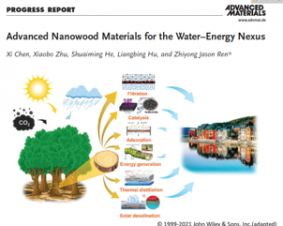 >
Spotlight April 2023: Recycling rare earths – bacteria assist in the circular economy
>
Spotlight April 2023: Recycling rare earths – bacteria assist in the circular economy
Rare earths are important components of wind turbines, catalytic converters, fibre optic cables and plasma screens. Since the 17 metals grouped under this term are indispensable for modern technologies, demand and costs are constantly rising. The occurrence of productive mining sites is limited and the production is often costly and environmentally harmful. The advantages of recycling these resources as efficiently as possible, for example from industrial waste water in the fields of mining, electronics or chemical catalysts, are obvious.
In cooperation with the University of Kaiserslautern, researchers at the Technical University of Munich have taken the circular economy of these demanded metals a huge step further: they examined several strains of cyanobacteria for their potential to bind rare earths from aqueous solution – and were successful.
The researchers determined the potential for the so-called biosorption of the rare earths lanthanum, cerium, neodymium and terbium for twelve strains of cyanobacteria. Most of these strains had never before been investigated for biotechnological potential. They come from habitats with extreme environmental conditions.
In a further project, the scientists plan to carry out the experiments on a larger scale in order to advance the industrial application of the results.
Original publication:
Michael Paper, Max Koch, Patrick Jung, Michael Lakatos, Tom Nilges and Thomas B. Brück: Rare Earths Stick to Rare Cyanobacteria: Future Potential for Bioremediation and Recovery of Rare Earth Elements. Front. Bioeng. Biotechnol., Sec. Bioprocess Engineering, Volume 11 – 2023

Weitere Spotlights
Spotlight September 2021: Wood, the raw material of the future?
One of the greatest challenges facing humanity is to produce clean drinking water under the given circumstances of global warming, population growth and increasing littering. In September, we would like to present a review article that believes one approach to solve this problem is the use of nanoscale wood. In the review, “Advanced Nanowood Materials […]
Read moreSpotlight October 2020: Nanosafety – Topic of the Future
Research on nanosafety is a driver of innovation as the spotlight in July has demonstrated. But furthermore, this research field is built on routine as well if researchers look for the “needle in the haystack”. In many areas the safety research initiates the development of new methods, e.g. for the determination of nanoparticles within exposed organisms via […]
Read moreSpotlight March 2023: How can photovoltaics be made safe and sustainable?
Conventional photovoltaic systems often have only low efficiency, i.e. only a fraction of the solar energy is converted into electrical energy and made usable. For this reason, research is being conducted into innovative materials that can significantly increase the energy yield and thus also enable more electrical energy to be generated from renewable sources. However, […]
Read moreSpotlight August 2020: The nanoGRAVUR Grouping approach
In August, we would like to present a paper of the German BMBF project nanoGRAVUR. nanoGRAVUR dealt from 2015-2018 with the grouping of nanostructured materials with regard to occupational safety, consumer and environmental protection and risk mitigation. The approach is now described by the project partners in this paper.Due to the variety of synthetic nanomaterials and the numerous modifications (differences in size, shape, chemical composition and surface functionalization), the effort required to investigate effects and behaviour within the framework of regulatory requirements is…
Read more


